U-2A, AFV Club
AFV Club is well-known for their excellent armor kits, so I was pleased to find that AFV Club now is making some aircraft kits, too. AFV Club has released kits of the early U-2 series, like the kind flown by Francis Powers, during his shootdown, and capture, over the Soviet Union, back in 1960. The AFV Club kit represents a U-2C, and has the enlarged intakes of that version. I had Cutting Edge decals for the U-2A, the version with the smaller intakes, originally used for the J-57 jet engine. The intakes of the -A model are straighter than the bulged intakes,which were used for increased air flow when the J-75 engine was installed to give the U-2 better performance.
I had an original Hawk U-2A in the stash, so I cannibalized the intakes from the Hawk kit and used them on the AFV Club U-2C, to backdate it to a U-2A. The swap was fairly straight-forward and resulted in what I wanted, a U-2A for the decal sheets that I had. In the event, it appears that AFV Club also released a U-2A, but I never was able to locate one, so I converted what I had.
Alclad "Aluminum" was used, along with some ModelMaster red for the colored areas. The kit was built OOB, except for some scratched details in the cockpit, and some clear 5-minute epoxy nav lights. I used the old Cutting Edge decal sheets for the markings.
AFV Club supplied the "Howdah" sunshade, and a pretty nice suite of cameras for the "Q-Bay". Parts supplied in the kit, but not used were the slipper tanks, upper-fuselage canoe fairing, and, of course, the enlarged intakes.
I sure hope that AFV Club continues to make, and release, more aircraft,
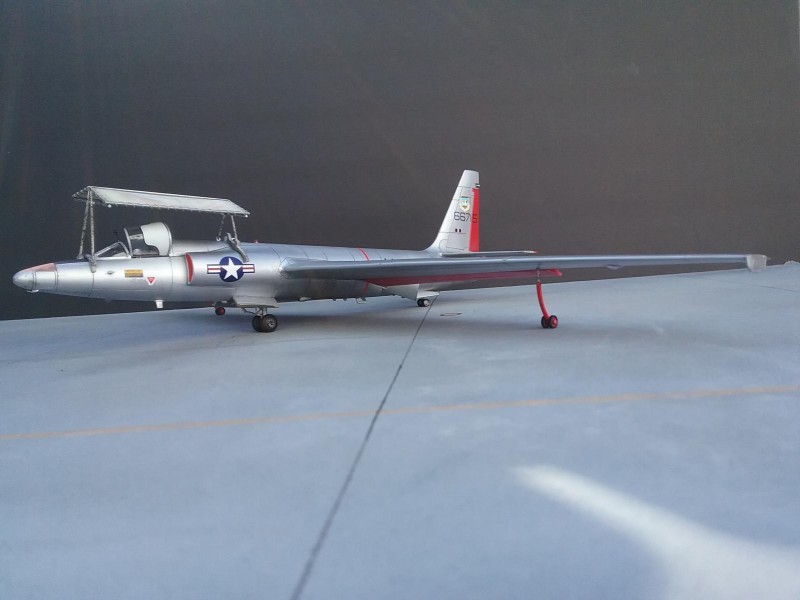
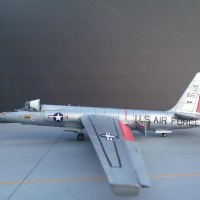
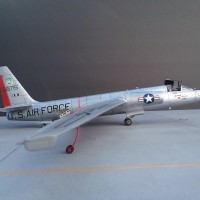
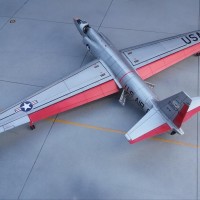

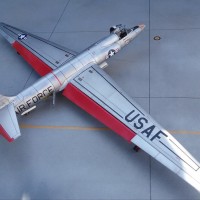
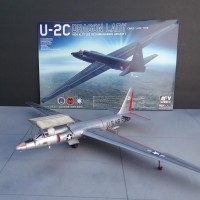
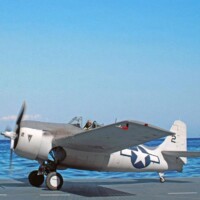
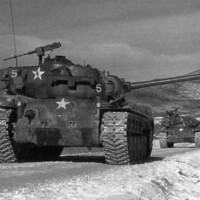
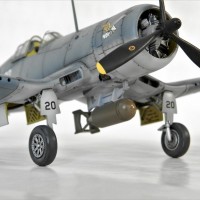

A very unique build, well done
Thank you, George...I appreciate it.
That is beautiful! I did not realize there were bare metal U2s.
Don: Thanks, I appreciate it.
The early U-2's were flown by both the CIA and USAF, and were usually left in NMF. Along the way, the CIA started doing overflights of Russia, and the aircraft used for these missions were painted dark blue as a form of camouflage in the upper atmosphere. Most of the U-2's that the USAF had on charge, were assigned to the Strategic Air Command, and these SAC U-2's were usually NMF, although some were later painted grey (corrosion control). In general, the early U-2's that look dark, belong to the CIA. One of these CIA aircraft (Article 360) was flown by Frank Powers, during his ill-fated mission on May 1, 1960.
Hey Don @donweixl and Marvin! There even seems, among others, a two grey camo to have been applied on a U-2 (a-C one): S/N 66700, 1975, 100th Strategic Reconnaisance Wing, sent to RAF Wethersfield under the Pave Onyx / Pave Nickel programs. This unusual camo had more to do with "politics" than tactical considerations. That U-2 might look more innocent than its blackish cousins!
You may see this camo and some more info here: http://wp.scn.ru/en/ww3/f/827/3/0
All the best, my friends!
2 attached images. Click to enlarge.
Spiros. Thanks for the camo U2 information. Very interesting.
Spiros: Thanks for the update on the U-2C camo scheme. You are correct about this scheme being politically-motivated; this two-tone, grey scheme was applied to assuage the sensitivities of the Brits, when 66700 conducted surveillance flights from the UK. I have seen 66700 in this scheme; it is hanging in the foyer of the Smithsonian's Air & Space museum, Washington DC (at least it was when I visited a few years back). I believe this two-tone camo scheme was a one-off, and 66700 is the only U-2 painted this way. Thanks for the summary, and great pix.
Thanks Marvin. I had no idea. I assumed all U2s looked like the same. Very interesting and worth some research.
Really good looking metal finish.
Thanks you, Haslam...I appreciate it.
This is definitely a kit I need to get. Your U-2 is absolutely STUNNING! Definitely a winner from every angle! Well done!
Thank you, Morne, your comments are sincerely appreciated.
I think the AFV Club U-2 is available, but, with the current situation, I'm not sure about delivery times. Thanks again.
Magnificent build, Marvin. I love NMF U-2s and your rendition really impressed me.
All the best!
Spiros: Thank you, Sir! You are very kind.
Man, that is great!
Thanks, Rob! I appreciate it.
Nice work!
Thank you, Joseph.
Absolutely perfect. Bravo!
Stephane: Thank you very much...I appreciate your warm comments.
This is the first completed U-2 model I see. Judging by your quality work, the kit must be a nice one. Great job
Pedro: The AFV Club U-2 is really a welcome release, considering that the original Hawk kit came out in the early 1960's. Matbe people will start building some models of this historically significant aircraft, now that a decent kit has been released. Thanks again, Pedro.
Good job on the kit and good improvisation using the Hawk intakes.
From what I understand, the AFV U-2A kit has the wider intakes of the C model. It's not a show stopper, but can be annoying if you want accuracy.
Thanks, Dan...I appreciate it. I have not seen the AFV Club U-2A, just the U-2C, that I used to build my model. I think that you are correct about the intakes on what AFV Club claims is an -A model; the original U-2A, with the J-57 engine had the straight, smaller intakkes, with absolutely no bulge, so, to backdate the AFV Club kit to an -A model requires new intakes. I considered simply grinding down the kit's bulged intakes, but the was not enough plastic there to allow that optio...so, I had to sacrifice the original Hawk kit to get the smaller intakes.
Perhaps, some aftermarket vendor will produce some small intakes...who knows?
Great looking build, Marvin. I suspect you don't see too many of them built because of the amount of real estate they take up on the shelf.
Thank you, George, I appreciate it. Yes, the U-2A in 1/48th scale, requires some shelf space; those long wings need their own room!
Impressive build and an interesting article!
Just a quick one though. What is the procedure for landing if the wheels on the wings are jettisoned?
Thanks Richard, I appreciate your comments.
Re: the U-2 landing procedure; the "pogo's drop off at takeoff, then the aircraft lands using the main gear, located on the fuselage. Once on the ground, the aircraft may settle to on side or the other, with the wing-end skid plates touching the ground. The outrigger "pogo's" are only used on the ground, pre-takeoff. Interestingly enough, this droppable outrigger gear is still used on more modern versions of the U-2 to this day. It was a solid idea, that has lasted the test of time. And, to this day, landing a U-2 is still an adventure, simply because the long wing has so much lift. It takes the pilot in the cockpit, as well as groundcrew in a chase car, to land a U-2S.
Thanks again, Richard.
Oh right, I had no idea that was the case. I would have thought such a long wing would easily break if it hit the ground, but obviously not!
Cheers for the info, every day is a school day.
perfect
Thanks, Bob
A great job in back dating, looks great!
Thanks, Robert. This was a fun build, without too much drama. The AFV Club kit goes to gether well, so that really helped. Thanks again!
My JROTC instructor, Major Whited, used to help work on these planes. I've been meaning to get one and build it for a while now. If I were to get this kit, what would your suggestions be for it? You have nailed it beautifully.
Jordyn: Thanks for the wonderful comments...I appreciate them.
The AFV Club U-2C can be used to make a very nice CIA bird, one that looks like the ones used for the overflights over the Soviet Union. The kit has slipper tanks, as well as the short and long fairings for the upper fuselage. The kit also has a nice decal sheet, that contains markings for USAF, CIA, and Taiwanese "Black Cat" squadron versions.
It's really up to you, your reference material, and your imagination as to which model you want to build; the AFV Club kit is a great place to start. I would recommend doing an image search on Google to view different U-2 pix. Find something that you like, then build it. Good luck, and thanks again.
Thank you for the info! And again, great build.
That's one excellent build of a great subject. The Lockheed Skunk Works sure did develop some interesting aircraft.
Thanks, Tom, I appreciate your kind words. Yes, the Skunk Works did (and continues to do) great work. Kelly Johnson was a genius in aircraft design, and organizational management; the Skunk Works, and its designs, is his lasting legacy.
a great-looking U-2! Recently finished One Minute To Midnight (Cuban missile crisis) and it was really interesting reading about the two "famous" U-2's involved in the incident - most interesting was the one that strayed over Soviet airspace. Great work on this.
Thank you, Greg...I appreciate it. Thanks for the reference to the Midnight book; I'll check it out.